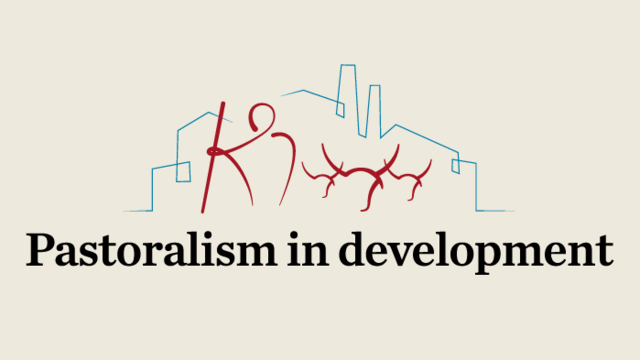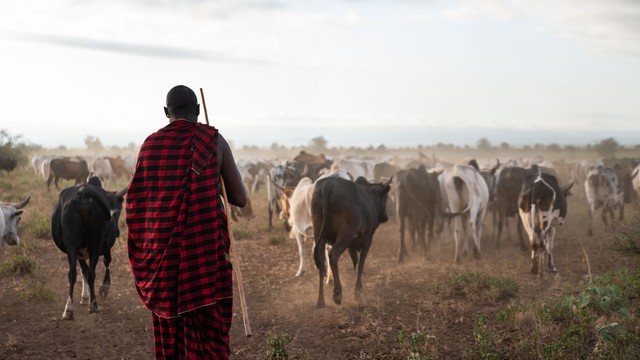The Sahelian Great Green Wall: start with local solutions
The regreening of the Sahel region through a 'Great Green Wall' appears to be an ambitious plan to roll back the ‘advancing deserts’ of the Sahara. However, the expertise and interests of local farmers and pastoralists inhabiting the drylands seem to be absent (yet again) from this strategy.



Cattle herd settle on village fields during the dry season (Photo: copyright Camilla Toulmin)
On 11 January at the One Planet Summit, President Macron of France announced US$14 billion dollars of funding for the Sahelian 'Great Green Wall'. Stretching across 8,000kms and 100 million hectares, the ‘advancing deserts’ of the Sahara are to be rolled back through the planting of trees and greening of landscapes across the Sahelian region.
Visible from space and pronounced a ‘wonder of nature’, the symbolism of a wall reversing environmental degradation, quelling insurgency and conflict and stemming the flow of migrants is dramatic. Following the announcement, press releases, media coverage and celebrity endorsements sang the praises of the initiative as a ‘game-changer’ for Sahelian development.
It is certainly a lot of money, offered by France, the World Bank and others. But how will it be spent, and can it make a difference? This is not the first time the Great Green Wall has been announced, of course. It was originally launched in 2007, again with much fanfare, but the track record since then has been less than impressive.
While the websites list glowing achievements across the region, the statistics behind these leave many questions unanswered. There have been many trees planted, but how many have survived, and what are the gains for the farmers and pastoralists inhabiting the drylands of the Sahel? Is such a grandiose, continental strategy the right approach?
Questioning simplistic narratives
Debates about desertification in the Sahel go back a long way. The narratives of encroaching deserts, deforestation by farmers and overgrazing by pastoralists have a long history. As described so well by Jeremy Swift, in 1934 colonial scientist E.P. Stebbing first claimed that the Sahara was expanding year on year.
This was based on faulty analysis, but at the time it fed into the doomsday idea of environmental degradation, provoked by the experience of the American dust bowl. Huge efforts were made in top-down soil conservation measures along with the regulation of farming and livestock-keeping populations.
This pattern of ‘the expert knows best' has persisted, with even greater imperatives now added to the agenda. Popular perception sees mass migration being provoked by over-population and climate catastrophe, while armed insurrection is attributed to environmental degradation and the collapse of local livelihoods.
Local people – their expertise, interests and history – are absent from the analysis. The story is much more complex: simplistic Malthusian narratives are widely disputed, and labour shortage may be more of a problem than population growth.
The simple storyline that the Sahara is expanding and in need of a 'Great Green Wall' to stop its spread has been thoroughly challenged. Dryland degradation emerges through a complex interaction of processes, and does not expand in a single direction.
Satellite imagery and archaeological evidence from these dryland regions show wet and dry periods, with the greening and drying of landscapes occurring in phases over time. These are highly variable settings, where attempts at stability and control are futile, and livelihoods are best served through diversification, risk spreading and mobility.
Trees have always been integral to Sahelian farmed landscapes and, although many have been cut as farming expands, most fields retain trees for fruit and shade. This in turn offers livestock a resting place during the midday heat, and deposits of dung help replenish soil fertility and nourish crop yields. In the wider landscape, there are more trees than had been thought.
A recent study found 1.8 billion trees in the Sahara and Sahelian regions of West Africa that had not been picked up by earlier assessments. Planting new trees may not be the solution if regreening can occur through natural regeneration of trees and shrubs.
Beyond tree planting to livelihood regeneration
How then can the noble ambitions of the 'Great Green Wall' initiative of tackling poverty and improving the sustainability of livelihoods be realised? As the publicity material around the effort makes clear, it is not just about planting trees, although this is clearly a central feature.
The broader involvement of bodies like the International Fund for Agricultural Development (IFAD) suggests a shift in emphasis towards small-scale farming and support for local community initiatives.
Twenty-five years ago, with Chris Reij we co-edited 'Sustaining the soil', which contained multiple cases of locally-generated practices for managing soil and water in a dryland farm settings, with many of the examples taken from the Sahel.
One of the most famed is the traditional ‘zai’ planting pit, improved and popularised by Burkinabé farmer Yacouba Sawadogo, and a practice long-used to conserve moisture and preserve soils across the Sahel. The expansion of such techniques has since become standard practice for NGO and government programmes alike.
As our book pointed out, it is not the technology alone that’s important, it’s how it well it fits within a complex social and ecological setting.
Looking back over 40 years of work in a Sahelian village in central Mali, a book by one of us – 'Land, Investment and Migration' – provides an insight into how livelihoods and landscapes shift in concert over time, and how the entire farming system can be put in jeopardy by ill-judged, large-scale government interventions.

Oxen drawn ploughs are a critical part of farming systems in the Sahel region (Photo: copyright Camilla Toulmin)
Alternatives driven from below
Moving beyond the glamour of big announcements from the Elysée Palace, can this moment offer a window for an alternative approach for Sahelian development?
Sadly, there are many forces set against this. Standard narratives about desertification persist, promoted by many, despite sustained empirical challenge. Climate change can become a catch-all explanation for failures in governance, while in the Sahel security and counter-terrorism agendas can get wrapped up with ‘development’.
The political obsession with targets – so many trees, this number of hectares, such-and-such an amount of money to be disbursed – can create huge distortions. Large amounts of aid money for cash-strapped governments can also result in distorted incentives, and sometimes corruption.
Too often, decisions are made on a map in a far-away office about an area deemed to be ‘empty’ and suitable for ‘regreening’. Across the Sahel, dryland farmers and mobile livestock keepers have kept a wary eye on each other’s strategy. Conflicts may emerge, when land is constrained – for example by huge blocks of irrigated agriculture, tree planting or soil conservation investments.
Pastoral herders may be unable to move their animals to the dry season grazing they could formerly negotiate with settled villagers, in exchange for manure, milk and other livestock products. A green wall risks becoming a further barrier to people’s livelihoods, not just a symbolic wall against a mythical advancing desert.
A focus on regenerating landscapes and promoting livelihoods through a sensitive, locally based approach to sustainable development is the way forward, and likely will cost less than $14 billion.
Most important is the recognition that there are numerous existing practices – of soil conservation, water control and tree management – that already constitute ‘nature-based solutions’ generated from local initiatives.
Yes, these need support, but giving agency to local voices, strengthening rights over land and water, emphasising grounded practices, and ensuring accountability will be more likely to create the sustainable mosaic of green patches across the Sahel that one day may be seen from space.
This blog was originally posted on the IDS website.



